Culture
Smuggled Photos from North Korea
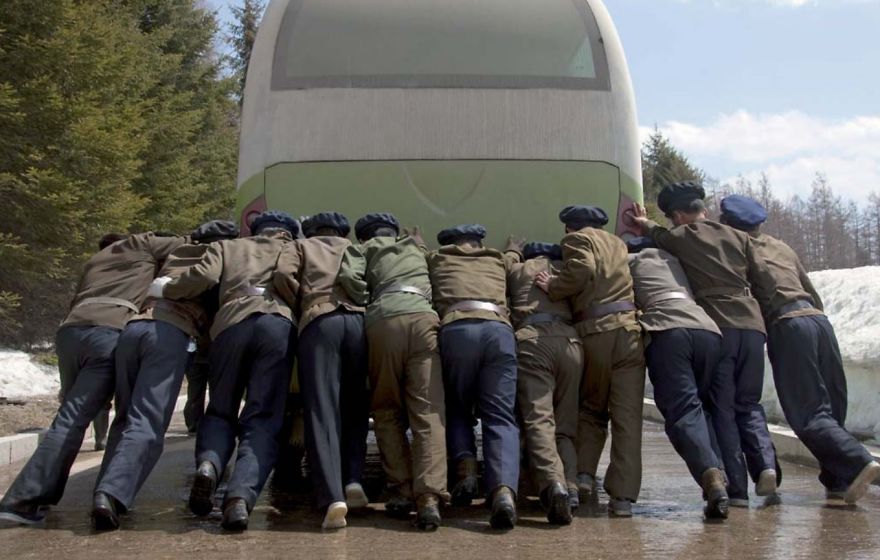
Not many people from the West can honestly say they have a firsthand knowledge of what North Korea looks like today. Most of the knowledge the West did have came from the Korean War, which is severely outdated. However, a few modern visitors have made it into the country and back out again, not only with their memories but with photographs as well. The highly insulated nation has been aggressively anti-open towards any source that shows the accurate picture of life inside North Korea, so almost all photos aside from the government itself have been smuggled out. Here is a set of images from Eric Lafforgue was able to get out because of the advance of digital storage and small memory cards versus film cannisters.
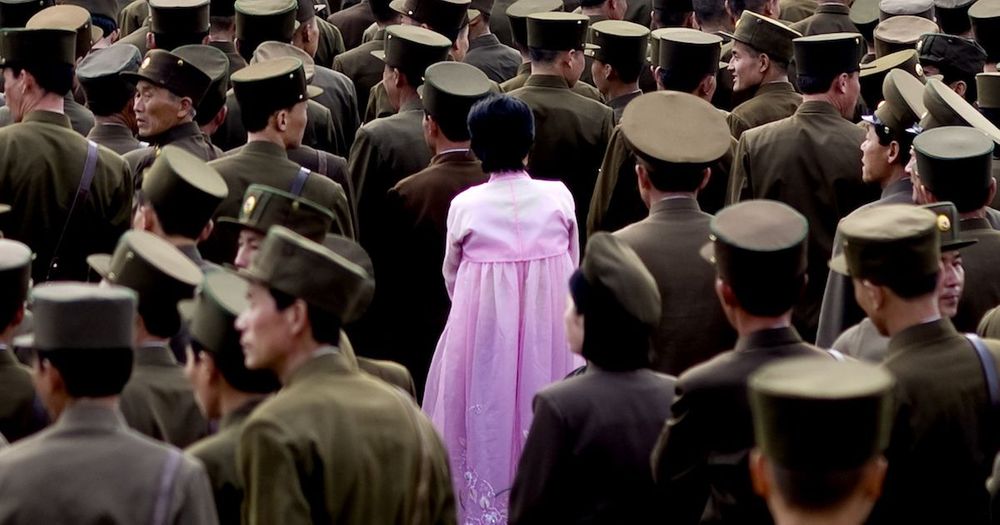
The Woman Among the Soldiers
Much of Eric’s tour around North Korea was what the government wanted him to see, one of those things being how strong their military should be seen as. So, no surprise, he had a lot of photos of soldiers. In this case, however, he was also able to capture a sole North Korean lady in traditional dress among a sea of uniforms.

Computer Access
The computer age has made it to North Korea, which has been well-documented by the attack on Sony. However, from the government’s perspective, computers are a tool of the people’s ability to be education and effective. So, there were lots of photos showing technology advancement. Unfortunately, the computers were only functional when there was power. Blackouts are common in North Korea.
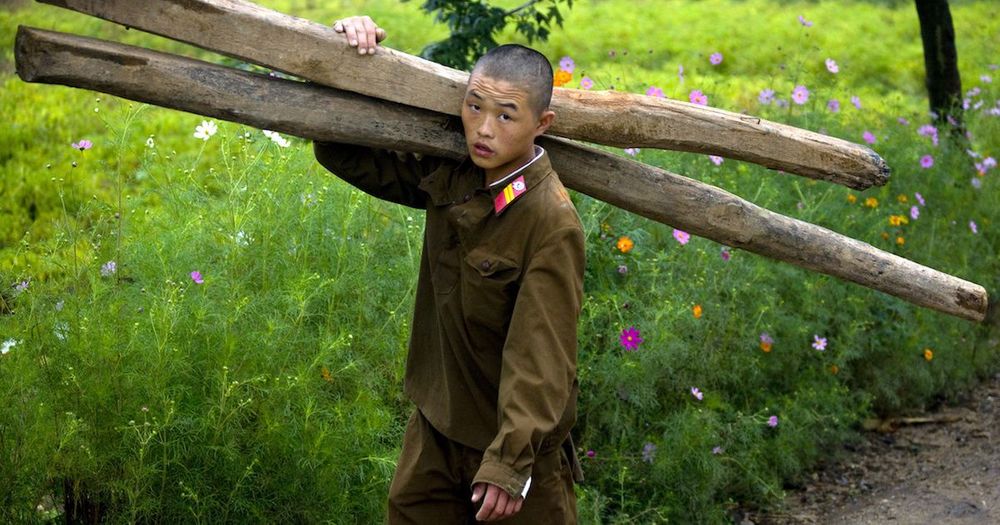
Military Work Means Farm Work
Farming is essential for the country. North Korea has had multiple famines, so it’s food production is critical for maintain the country as a whole. The military is no exception, often being used as manpower to assist farms and keep them functional. Eric’s photo of this soldier showed policy in action.
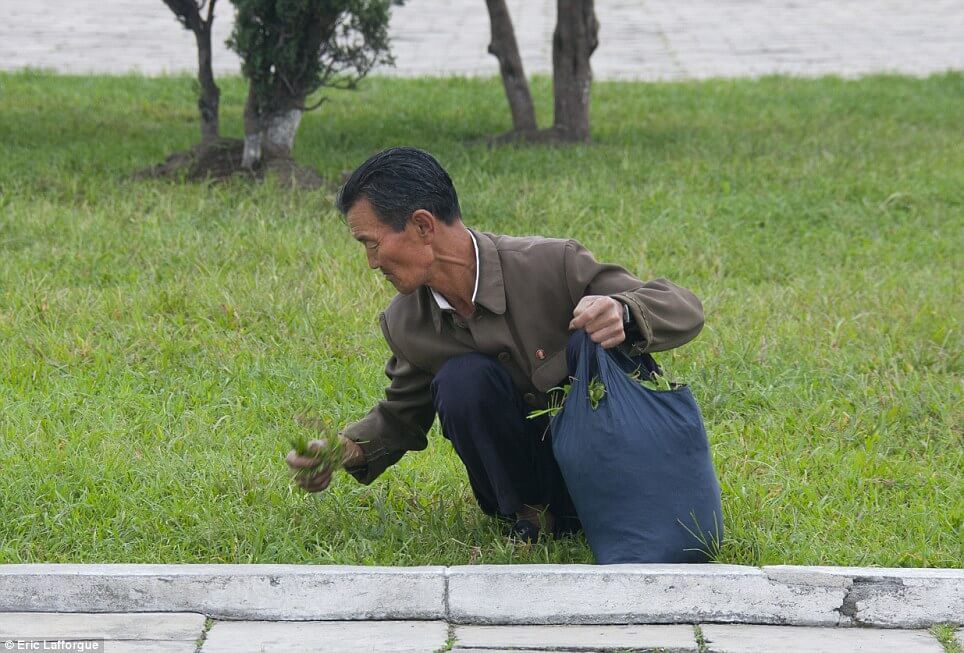
Eating the Grass
Hunger is commonplace for the average person in North Korea, which makes it no surprise why so many lean towards finding a role in some kind of apparatus – at least they get a guaranteed meal every day. Unfortunately, what Eric saw was a lot of other people starving, even to the point of harvesting grass to eat it and make it to another day. His government minders made it clear no one should take photos of the practice.
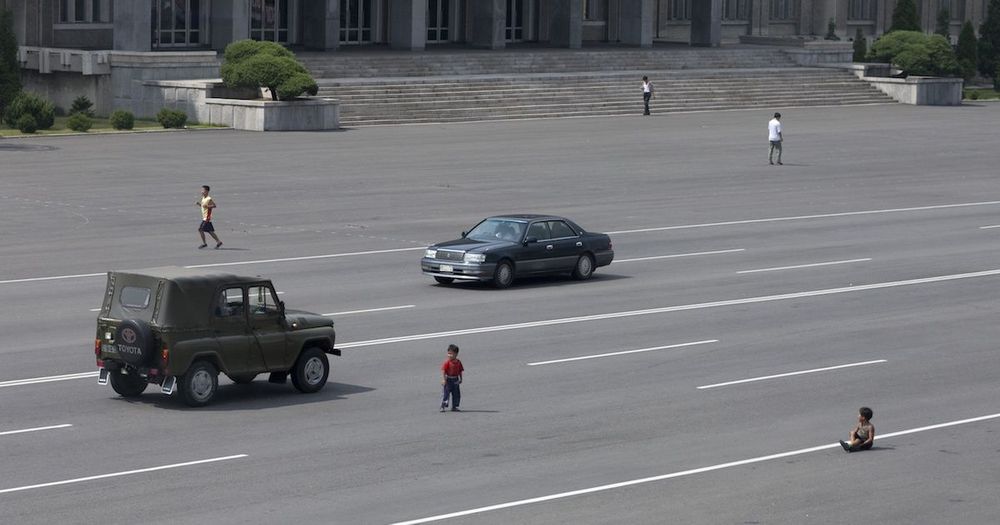
Kids Playing
Children are extremely controlled and disciplined in the country, so it was an odd experience to find one just being a normal kid and standing out, as in this case in the middle of the road. Curiosity and adventure are normal for children as they explore the world, but the behavior is practically banned in-country.
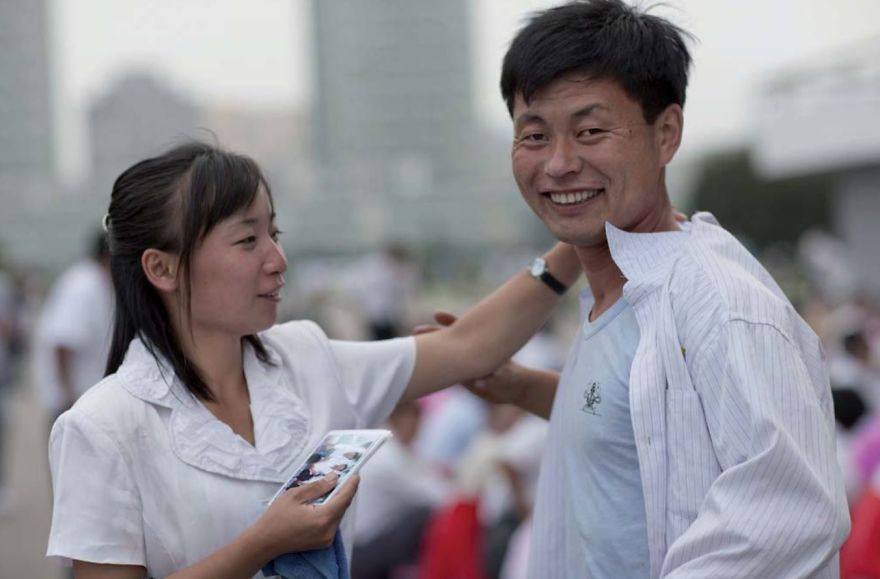
Appearance Matters
The government has very clear rules about how everything is displayed in the country, even how people are dressed when photographed. Eric was able to catch this interaction where a man to be photographed is essentially being straightened out to look more presentable, i.e. get his shirt unruffled.
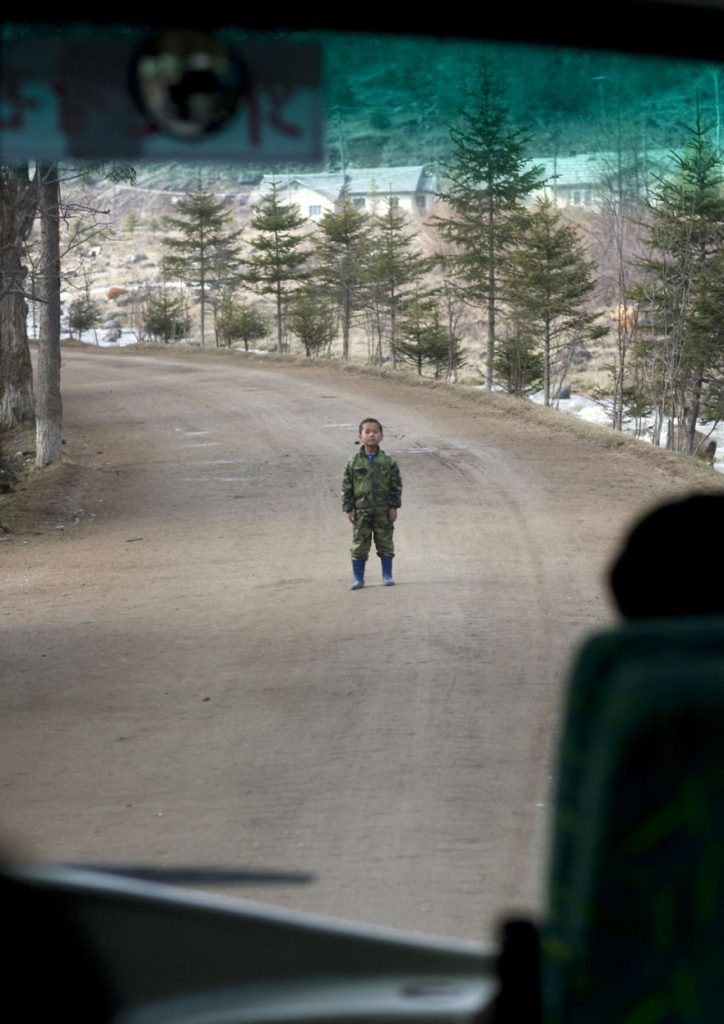
Cars are a Rarity
Most people in North Korea only see a vehicle when it involves the military. However, in the main cities a few more are seen regularly as government officials use them in and out of locations. Cars are starting to be a bit more frequent in terms of non-military use, but they still frighten folks in the rural areas.
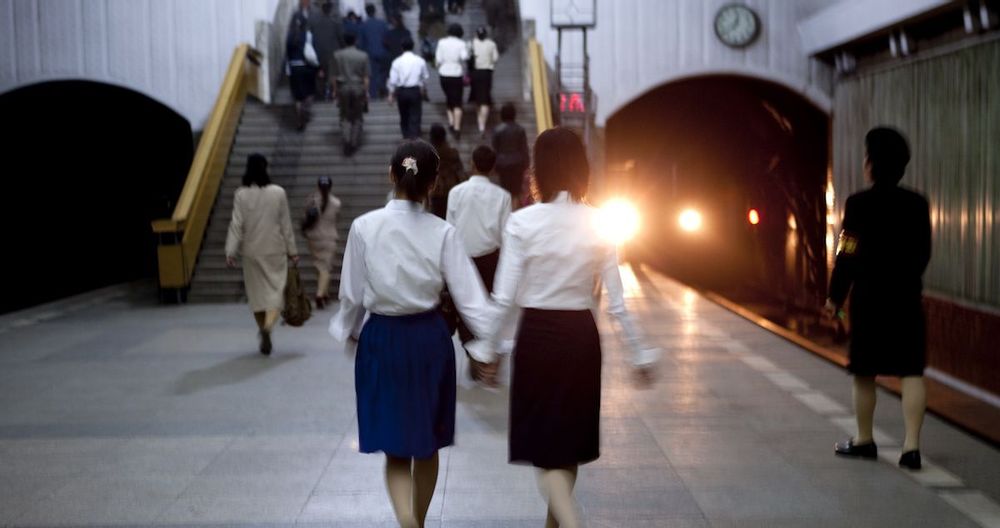
Double Duty Subway
The subway system for Pyongyang was intentionally designed for more than transportation. It also functions as a ready-made bomb shelter for a significant number of inhabitants of the capital. Photographs showing the tunnels are forbidden and Eric was immediately told to delete this image.
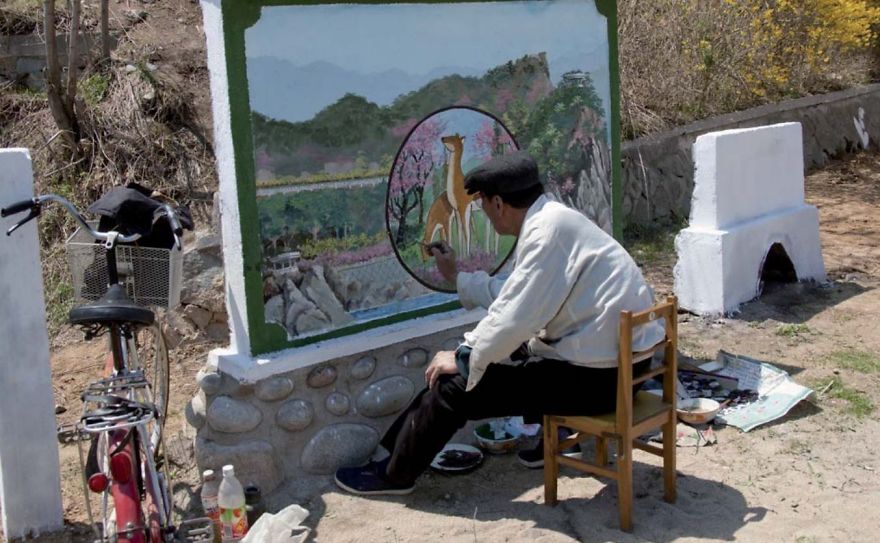
Art has to be Finished
The government has a real problem showing anything unfinished and unapproved, even in the case of artwork being developed or created. That was the case with this painter who was photographed during his work. The government minders made it clear the picture was unfinished and off-limits.

Signs of Famine Barred
Clearly the North Korean government wants any image of its people to show them as prosperous and happy and most importantly, well-fed. That was not the case with this fellow who clearly evokes an image of malnourishment.
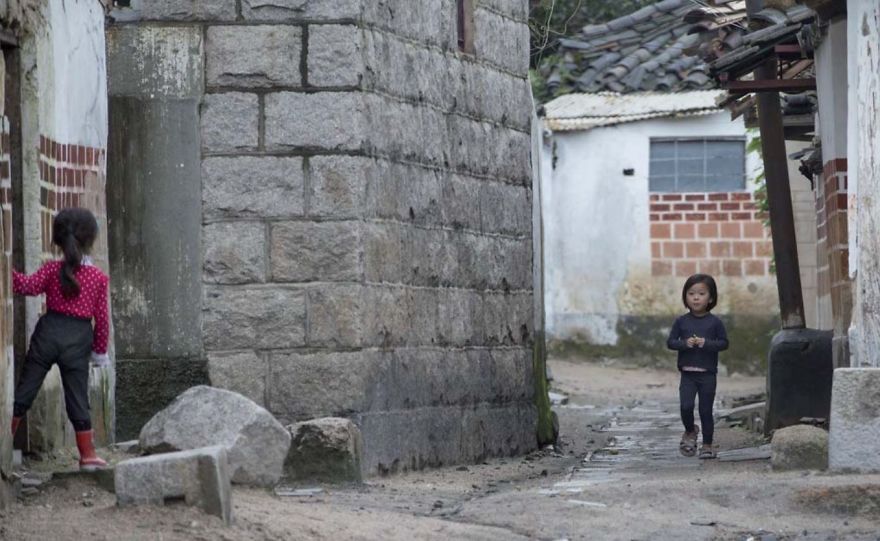
DMZ Hotels
Any hotels near the DMZ are very restricted to the point that the guests are not allowed to walk outside on their free time. However, most of the accommodations are actually old houses in the area. Any guest attempting to go outside will likely block a guest asking why they need to go outside. The common phrase is that it is the same as inside the hotel.
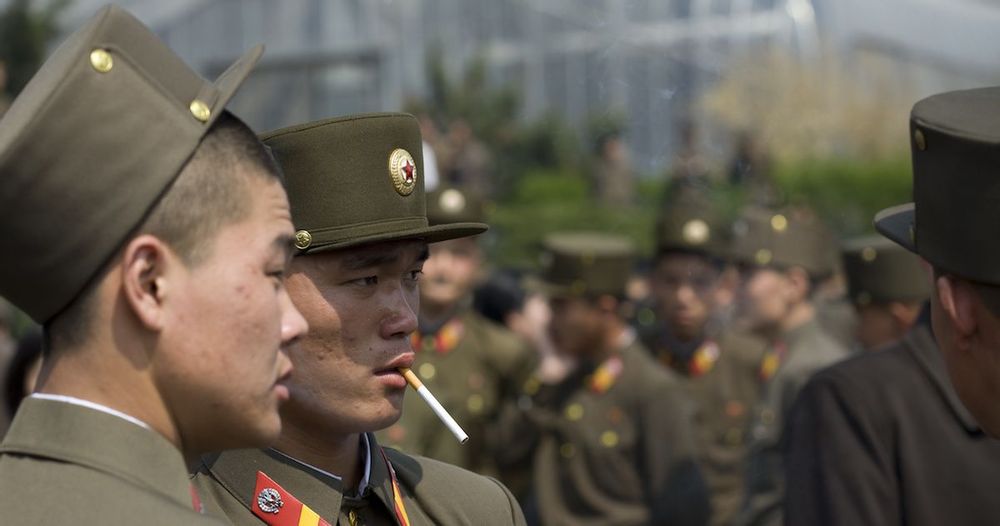
No Soldiers Relaxing
Soldiers in North Korea are always seen at attention. So, actually capturing an image of soldiers just being human beings was a big no-no. Eric managed to grab this image of a couple uniforms just having a cigarette and conversation. It’s a big risk as the country has a national law forbidding photographs of people’s faces when doing things that are considered embarrassing to the government.
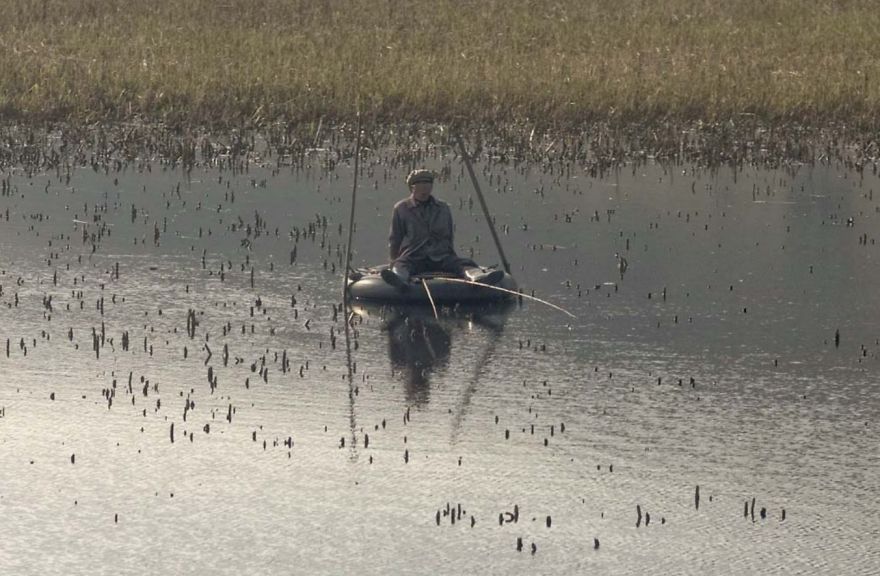
Creative Boating
One fellow decided to a tire was good flotation device to get from one place to another on water. The image looks typical of a countryside, but what it really might be indicative of is the fact that even natural resources like wood are controlled and extremely rare for use other than the government.
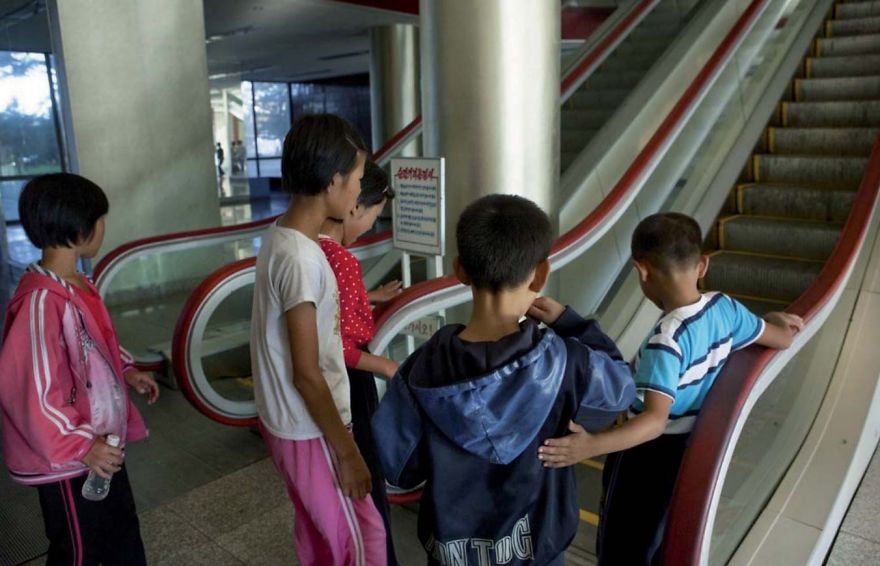
Kid Camps
Wonsan has a Pionners Camp designed to help education children from all over the country. However, for many of the first time attendees, the facility itself is scary and nothing they’ve ever seen in the countryside. That was the case for these kids staring at an escalator.

The Challenge of Group Photos
Again, Eric was told with certain clarity, none of his photographs were allowed have military personnel in them. That’s fine when the soldiers are stationed at military functions, but it becomes a real problem when 99 percent of the crowd at a zoo or amusement park is military personnel. That was the case in this event at the Delphinium located in Pyongyang.

Lines, Lines Everywhere
A common practice in North Korea involves standing in line. Just about everything involves a line and mass queues are commonplace, even for taking the local bus as seen in this image of the main plaza connection point.

People Must Be Shown Respectfully
The idea that an official is ever portrayed not doing their job correct is never allowed, so photography of that happening is a huge problem for the photographer. Eric managed to catch an image of this official snoozing, which would never have been allowed past the normal censors had they seen in it in his allowed images.

Normal Life is Rough
Visiting groups are shown the best of homes to prove that North Korea is just fine for the average person, even in the country. However, the details give away what’s really going on, as in the case of this bathroom that uses a bath tub and installed water pump for the general water supply for everything.
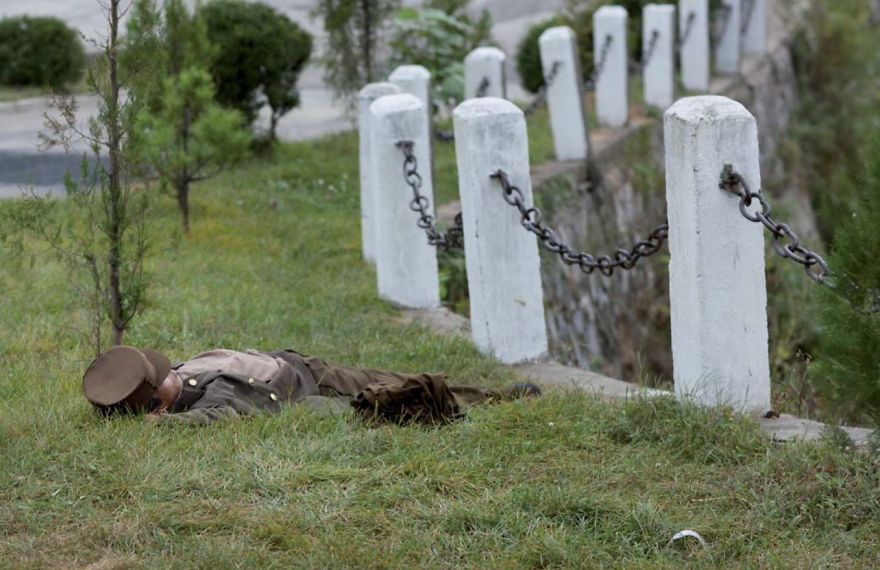
Sleeping Off Duty
Military personnel are expected to wear their uniform all the time, even when off-duty. So, it’s not a surprise to see a fellow catching a nap when he can, as was the case with this one in a field.

Poverty
Photos of the poor in North Korea are also forbidden, and it doesn’t matter if one argues that poverty exists in every country, even in the West. Yet, just about everyone in the countryside lives in poverty unless they are military or running a collective farm. These two kids carrying buckets aren’t showing hard disparity, but it’s not a luxury life either.
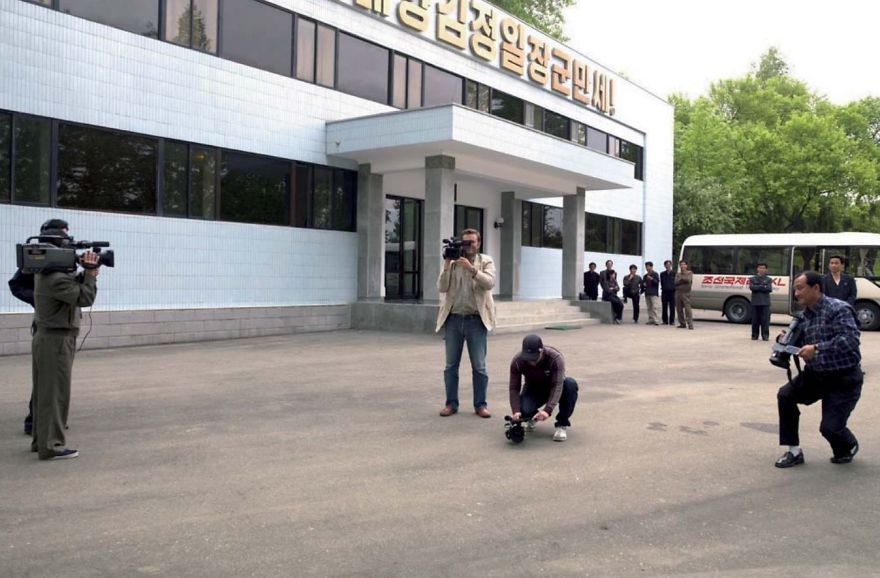
Tremendous Monitoring
Any visiting groups are monitored heavily in North Korea, and one has to wonder how the country sustains itself with so many personnel dedicated to watching others instead of producing anything themselves. It’s very common for visiting media to be followed and watched by two, three even four groups of monitors, so it’s amazing Eric was able to smuggle out any images at all.
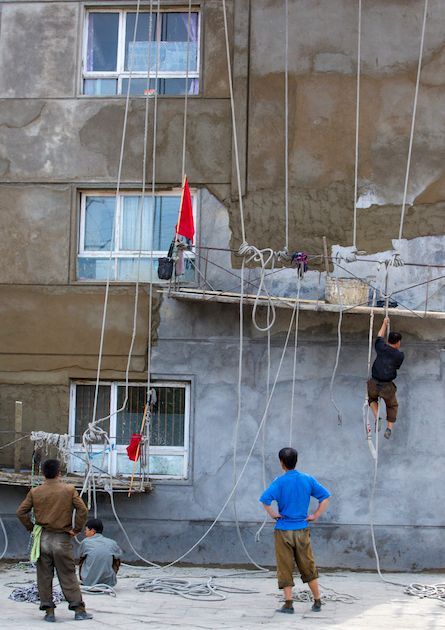
There’s No OSHA in North Korea
Worker safety is how well the workers protect themselves. Occupational safety standards as known in the West don’t seem to exist in the country. That was evident in this image of wall repair crews that Eric took in a key moment.
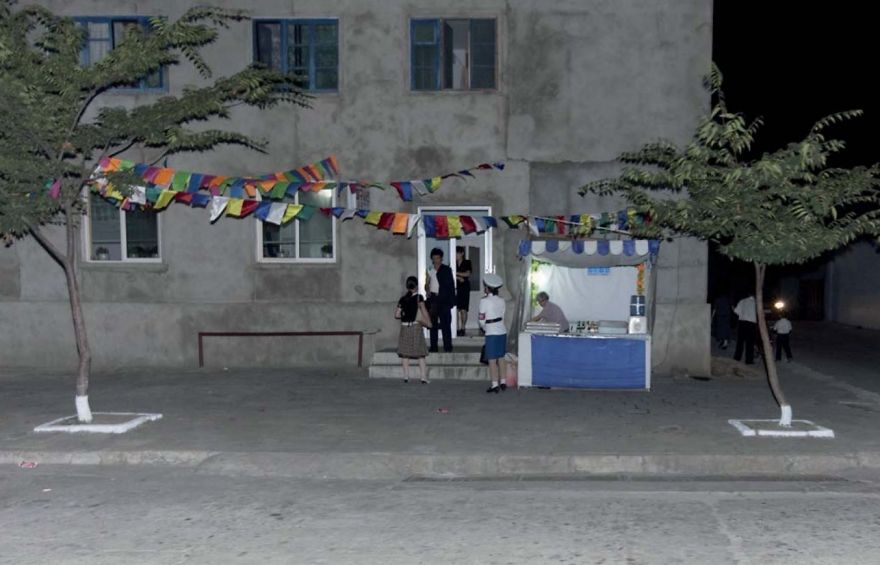
Flash Photography Banned
If you’re the type who likes to take night photos with a flash, good luck. They are often not allowed, and minders will tell you it’s because the flash might scare the locals.

They Have Grocery Stores
The market stores in Pyongyang carry many of the recognizable products people are used to in the West. The issue is who actually shops in these markets. While you can easily find Evian water, for example, the customers allowed are only the country’s elite.
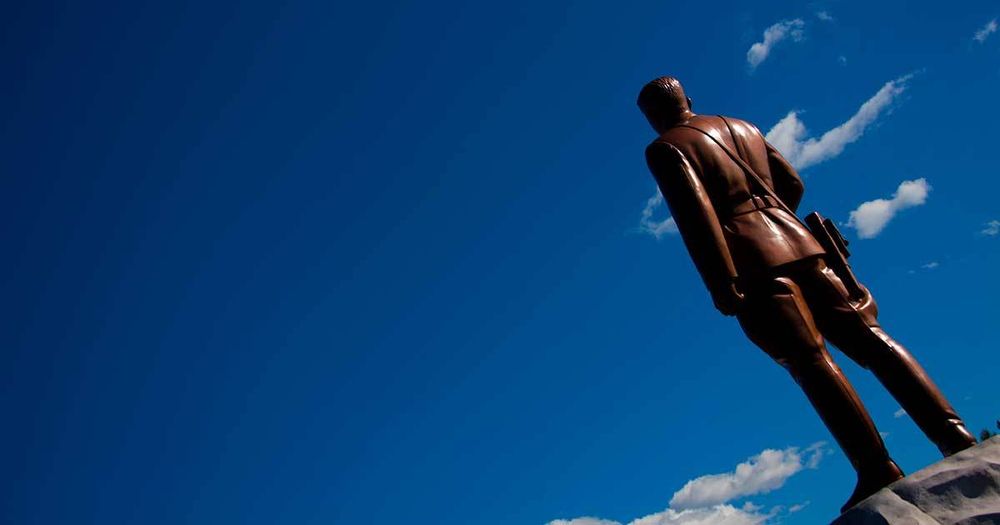
Tip for Tourists
Never take a photograph of the country’s leader from the back, especially statues. Rear images are not allowed and will get you into a lot of trouble. They are considered culturally rude to produce.
Culture
Farmer’s Legacy Protects Critically Endangered Plains-Wanderer
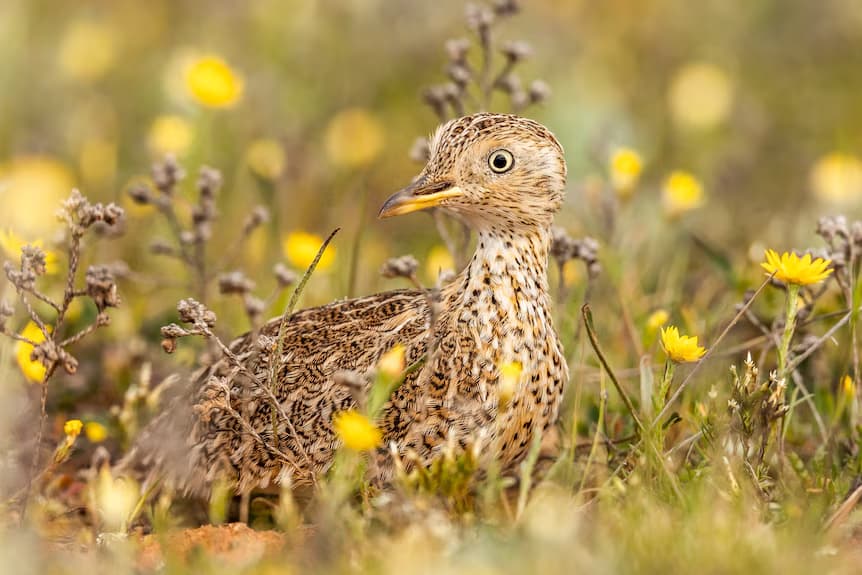
Ten years ago, George Cullinan stumbled upon a curious bird on his farm in Victoria’s Mallee region. The bird, which he found lifeless in a water trough, had yellow legs and a yellow beak that sparked his curiosity. Wanting to learn more, Cullinan reached out to his friend and conservationist, Greg Ogle. What he discovered was remarkable—the bird was a plains-wanderer, one of Australia’s rarest species, with a dwindling population of just 250 to 1,000.
Cullinan, who passed away at the age of 98 just three weeks ago, left behind a lasting legacy. His conservation efforts are now helping protect this critically endangered bird, whose habitat has significantly shrunk over the years. Once widespread across parts of Australia, the plains-wanderer is now mostly found in limited areas of Victoria, South Australia, and southern New South Wales.
The plains-wanderer is an ancient species that evolved over 100 million years ago. Its unique status makes it a top priority for conservation, according to the Zoological Society of London. With its distinctive call that resembles a cow’s moo, this small bird is now fighting for survival due to habitat loss.
Working closely with Trust for Nature and the Birchip Landcare Group, Cullinan took significant steps to help the plains-wanderer thrive on his property. By installing song meters equipped with microphones, Cullinan’s team was able to capture 110 distinct calls of the rare bird within just three weeks—clear evidence that more than one bird inhabited his land.
To ensure the long-term survival of the species, Cullinan established a 91-hectare conservation covenant on his 2,000-hectare farm in 2024. This protected area, featuring a shallow lake and ancient box trees estimated to be 500 years old, provides the perfect conditions for the plains-wanderer. Known as the “Goldilocks” bird, the plains-wanderer requires ground cover that is not too dense but not too sparse—conditions met by Cullinan’s property.
David Dore, Trust for Nature’s manager, emphasized that Cullinan’s land offered a “supermarket” of plants, such as spear grasses and lilies, where the plains-wanderer can find food throughout the year. Dore praised Cullinan’s quiet but monumental contribution to conservation, calling the farmer’s work an act of environmental activism that will leave a lasting impact.
Cullinan’s dedication to preserving the bird’s habitat was recognized at his graveside service last month. Brian Lea, a member of the Birchip Landcare Group, reflected on Cullinan’s enduring contribution. “His last gift to the birds is something that will keep him in people’s memories for a long time,” Lea said.
Cullinan’s conservation work ensures that the plains-wanderer will have a safe haven on his farm for generations to come, preserving the habitat of one of Australia’s most critically endangered species.
Culture
Guam Kingfisher Released into the Wild After 40 Years of Extinction
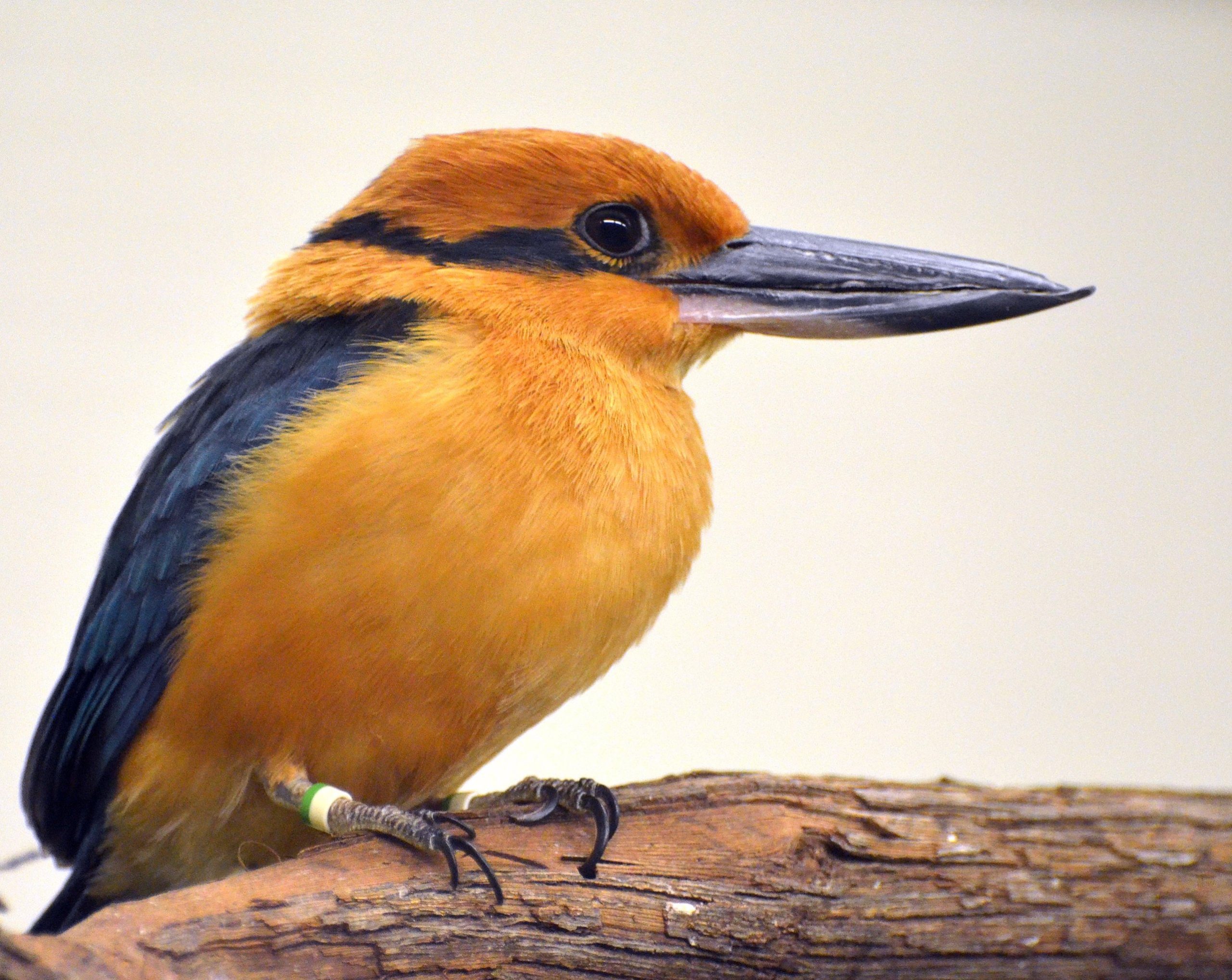
For the first time in nearly four decades, the Guam kingfisher, known locally as sihek, has returned to the wild. Six of these vibrant birds were released on September 23, marking a historic milestone in conservation efforts.
The sihek, which once flourished in Guam’s forests, had been declared extinct in the wild since 1986 due to the introduction of the invasive brown tree snake. This predator decimated the island’s bird population, including the sihek, by preying on their eggs. Fortunately, conservationists launched a captive breeding program, which kept the species from disappearing entirely.
The six birds were released on Palmyra Atoll, a predator-free island located about 3,700 miles east of Guam. This release is part of a long-term project aimed at establishing a breeding population on the atoll as a first step toward eventually reintroducing the sihek back to its native habitat in Guam.
The road to this moment began earlier in the year, with the hatching of the first sihek chick of the season at Sedgwick County Zoo in Kansas. Given that only 45 breeding females remain worldwide, each successful hatch is a critical victory for the species. Specialists from various institutions, including the Zoological Society of London and the Smithsonian’s National Zoo, worked tirelessly to care for the chicks and prepare them for life in the wild.
After being flown to Palmyra Atoll in late August, the birds spent time acclimating before their release. Each sihek is equipped with a small radio tracker to monitor their movement, habitat use, and eventual breeding behavior. Researchers will be closely watching the birds in the coming months as they adapt to their new environment and hopefully establish territories for breeding.
The return of the sihek to the wild has been the culmination of decades of collaborative effort between organizations like the U.S. Fish and Wildlife Service, Guam’s Division of Aquatic and Wildlife Resources, The Nature Conservancy, and several zoos. Their goal is to build a sustainable breeding population that can one day thrive in Guam’s forests once the brown tree snake threat is under control.
Although the release is a reason for optimism, conservationists remain cautious. With only a few dozen sihek left, the species faces significant risks, from disease to natural disasters. However, the successful reintroduction of extinct-in-the-wild species, such as the red wolf and California condor, proves that with dedication and proper resources, these efforts can succeed.
As Donal Smith, a researcher with the Zoological Society of London, pointed out, maintaining endangered species in captivity is no small feat. “Reintroduction programs like this require years of preparation and coordination. It’s essential that conservation efforts continue to receive the support they need to prevent more species from being lost.”
The sihek’s release offers a glimmer of hope in the face of ongoing environmental challenges. If all goes well, these birds will one day fly free in the forests of Guam once again.
Culture
From Conflict Zone to Conservation Triumph: Upemba National Park’s Remarkable Recovery
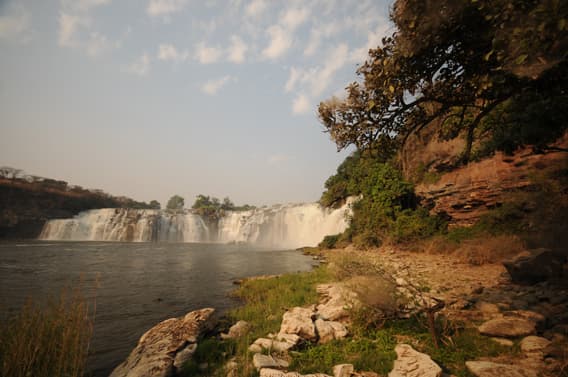
In the heart of the Democratic Republic of Congo (DRC), Upemba National Park is witnessing a remarkable transformation. Once dubbed the “triangle of death” due to rebel activity, this vast wilderness is slowly reclaiming its status as a thriving wildlife haven, thanks to the unwavering dedication of its rangers and conservationists.
The park’s tumultuous history began in 1998 when Bakata Katanga rebels sought refuge within its borders, leading to widespread poaching and devastation of wildlife populations. Elephants, lions, and zebras, once abundant, were pushed to the brink of local extinction. Even the park’s rangers, left unpaid during the Congo wars, resorted to poaching for survival.
However, recent years have seen a dramatic turnaround. Under the leadership of site manager Christine Lain, Upemba has secured crucial funding and revitalized its demoralized ranger force. The results are encouraging: elephant numbers have risen to about 210, while the zebra population – unique to this part of DRC – has rebounded from a mere 35 to an estimated 200.
Despite these successes, challenges persist. Poaching remains a threat, and the park faces potential disruption from nearby mining activities and oil exploration. To counter these pressures, park management is focusing on expanding the ranger force and conducting comprehensive biodiversity surveys to strengthen the case for Upemba’s protection.
The park’s recovery is not without human cost. Rangers like Sylvain Musimi continue to face danger from militant groups, with two rangers losing their lives this year alone. Yet, their commitment to Upemba’s restoration remains unshaken.
As Upemba National Park continues its journey from a conflict-ridden zone to a beacon of conservation, it stands as a testament to the resilience of nature and the dedication of those who protect it. The park’s story offers hope that even in the face of seemingly insurmountable challenges, conservation efforts can yield remarkable results.
Culture
From Warzone to Wildlife Haven: Ukrainian Intelligence Rescues Symbolic Owls
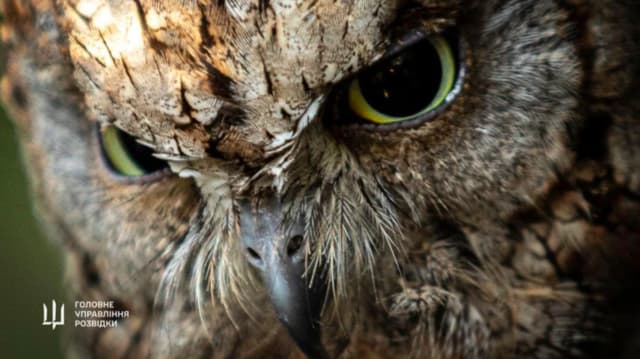
In a heartening tale of compassion amidst conflict, Ukraine’s Defence Intelligence (DIU) has facilitated the rescue and relocation of two owlets from the embattled Kharkiv region to Kyiv Zoo. This rescue operation, carried out on August 1, 2024, highlights the Ukrainian military’s commitment to preserving life in all its forms, even in the midst of war.
The young owls, now named Arei and Magura, were discovered by members of the 92nd Separate Assault Brigade during a mission near Lyptsi village. Found in dire conditions within a war-damaged structure, the birds were immediately taken into care by the soldiers.
Following their initial rescue, the owlets were brought to the attention of Kyrylo Budanov, Chief of DIU. Given the owl’s symbolic significance to Ukraine’s Defence Intelligence, Budanov made the decision to provide them a new home at Kyiv Zoo, where they will reside in a specially prepared aviary.
DIU representative Andrii Yusov emphasized that this rescue exemplifies the Ukrainian forces’ dedication to protecting not just human lives, but also those of animals caught in the crossfire. The decision to house the owls at Kyiv Zoo was motivated by a desire to share this positive story with the public, particularly allowing Ukrainian children to interact with these native birds.
Kyiv Zoo’s CEO, Kyrylo Trantin, expressed gratitude for the military’s efforts and assured that the zoo would provide comprehensive care for Arei and Magura, including rehabilitation and adaptation support. This rescue serves as a poignant reminder of the zoo’s ongoing efforts to safeguard animals during wartime.
This heartwarming incident stands as a testament to the Ukrainian people’s resilience and compassion, showcasing their ability to nurture life and hope even in the face of adversity.
Culture
Eco-Friendly Tourists in Copenhagen to Receive Free Food and Tours

Visitors to Copenhagen who participate in environmentally-friendly activities, like litter picking or using public transport, can earn free food, cultural experiences, and tours as part of a new pilot program.
The CopenPay trial, running from July 15 to August 11, turns eco-friendly actions into rewards, according to Visit Copenhagen, also known as Wonderful Copenhagen.
For instance, visitors who bring plastic waste to the National Gallery of Denmark can join a workshop to create art from the materials. Those who cycle or take public transport to the city’s famous heating plant can ski down the artificial slope on the building’s roof.
“CopenPay rewards actions like cycling, participating in cleanup efforts, or volunteering at urban farms with access to a variety of experiences in Copenhagen,” said Wonderful Copenhagen in a statement. “This includes free guided museum tours, kayak rentals, and even a vegetarian lunch made from local crops.”
Copenhagen is known for its beautiful architecture, excellent food, and clean, green environment. It’s also a great place for cycling, with 237 miles of bike lanes and 62% of citizens commuting by bicycle, according to the tourism board.
“With CopenPay, we’re helping people enjoy more of what Copenhagen has to offer while reducing their environmental impact,” said Mikkel Aarø Hansen, CEO of Wonderful Copenhagen. “It’s about creating enjoyable and environmentally responsible experiences.”
Tourists can earn rewards by showing a public transport ticket, but the system is mostly based on trust. An online map shows over 20 participating venues. If successful, the pilot project could become a year-round program.
This initiative comes at a time of growing concern over the environmental and social impacts of tourism, which have led to protests in Barcelona, the Canary Islands, and Mallorca.
“We need to change tourism from being an environmental burden to a force for positive change,” said Hansen. “An important step is changing how we move around, what we consume, and how we interact with locals.”
-

 OMG7 years ago
OMG7 years agoA Couple Gave Birth to the Most Beautiful Twins Ever
-

 OMG8 years ago
OMG8 years ago20 Rare Historical Photos
-

 OMG7 years ago
OMG7 years agoHilarious Airport Photos
-

 Cute7 years ago
Cute7 years agoMom Refuses to Let Daughter Eat Sugar and Years Later This is What She Grows Into
-

 OMG7 years ago
OMG7 years agoTop Secret Air Force One Facts That You Never Knew
-
OMG7 years ago
The Funniest Yearbook Photos Of All Time
-

 OMG7 years ago
OMG7 years agoRetired Mathematician Restores Log Cabin
-

 OMG6 years ago
OMG6 years agoWhat Happened When This ‘Duck Dynasty’ Legend Chopped Off His Beard?